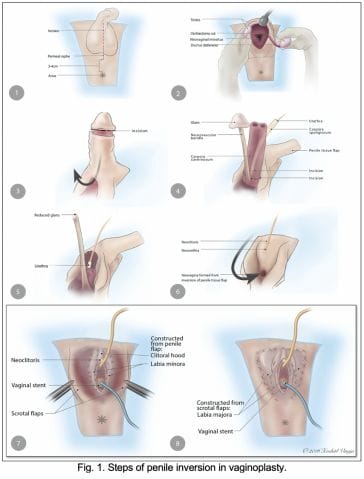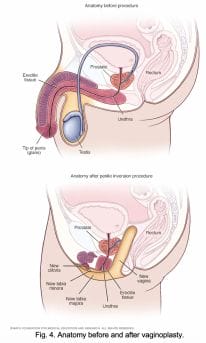Vaginoplasty surgery is one of the most transformative gender confirmation procedures, helping transgender women and non-binary individuals achieve alignment between their body and gender identity. At Tran Plastic Surgery in Huntington Beach, CA, Dr. Tuan Tran, a double board-certified plastic surgeon, specializes in delivering safe, functional, and aesthetically natural results tailored to each patient’s needs.
What Is Vaginoplasty?
Vaginoplasty is a form of gender confirmation surgery that creates functional female genital anatomy for individuals assigned male at birth (AMAB). This procedure is also known as bottom surgery or sex reassignment surgery.
The primary goals of vaginoplasty are:
-
Creating a natural-appearing vulva (labia majora, labia minora, and clitoris).
-
Constructing a sensate neovagina with adequate depth.
-
Allowing patients to achieve both aesthetic satisfaction and functional intimacy.
For many transgender women and some non-binary people, vaginoplasty is a life-changing surgery that enhances comfort, confidence, and gender affirmation.
Who Is a Candidate for Vaginoplasty?
Dr. Tran carefully evaluates each patient to ensure safety and the best outcomes. Ideal candidates typically:
-
Are in good overall health.
-
Have a confirmed diagnosis of gender dysphoria or intersex variation.
-
Possess realistic expectations about surgical results.
-
Are able to comply with pre- and post-operative requirements.
Before scheduling surgery, patients usually need:
-
A psychiatric evaluation and letters of readiness.
-
Routine medical testing such as blood work and an electrocardiogram (EKG).
-
Temporary cessation of hormone replacement therapy (HRT), typically two weeks before and after surgery.
-
Permanent hair removal in the surgical field, often via electrolysis or laser treatment.
Surgical Techniques for Vaginoplasty
Dr. Tran offers advanced surgical options, selecting the technique that best matches the patient’s anatomy and goals. The three most common approaches include:
1. Penile Inversion Vaginoplasty
The most widely performed method, penile inversion uses penile skin to form the vaginal lining, while scrotal tissue creates the labia. Key features include:
-
Functional, sensate vagina and labia.
-
Ability to add grafts for additional vaginal depth.
-
Possibility of partial self-lubrication using urethral mucosa.
Consideration: This method does not naturally provide full lubrication, so patients may use external lubricants during intimacy.

2. Rectosigmoid (Colon Graft) Vaginoplasty
This technique uses a section of intestinal tissue to construct the vaginal canal. It may be chosen when penile and scrotal tissue are limited. Benefits include:
-
Naturally self-lubricating neovagina.
-
Reliable vaginal depth and width.
-
Proven reconstructive option also used for cisgender women with congenital vaginal absence.
Consideration: The procedure is more complex and carries intestinal surgical risks, but it offers excellent long-term functionality.
3. Non-Penile Inversion (Suporn / Chonburi Flap Technique)
This technique employs scrotal tissue grafts for the vaginal lining and repositions penile tissue for the labia minora and clitoral hood. Benefits include:
-
Greater vaginal depth.
-
Enhanced sensation in the inner labia.
-
Improved cosmetic results.

Recovery After Vaginoplasty
Patients remain hospitalized for approximately 3–6 days following surgery for monitoring and catheter management. Key recovery milestones include:
-
Week 1: Initial post-op check with Dr. Tran.
-
Weeks 2–6: Swelling, bruising, and discomfort gradually improve.
-
Months 2–3: Most patients resume normal daily activities, with restrictions on strenuous exercise and intimacy until cleared.
-
Ongoing Care: Vaginal dilation is essential to maintain depth and prevent narrowing of the neovagina.
Risks and Potential Complications
As with all major surgeries, vaginoplasty carries risks. Dr. Tran prioritizes patient safety by discussing these openly during consultation. Possible complications may include:
-
Temporary urinary incontinence.
-
Reduced or altered sensation in the neoclitoris.
-
Vaginal prolapse or narrowing.
-
Rare but possible rectovaginal fistula.
Most complications are rare and manageable with prompt medical care.
Insurance Coverage and Costs
In California, many health insurance providers—including CalOptima—cover vaginoplasty as part of gender confirmation surgery. Our team helps patients navigate insurance approvals and provides transparent financial guidance for any out-of-pocket costs.
Why Choose Tran Plastic Surgery?
Choosing the right surgeon is the most important step in your gender affirmation journey. Patients trust Dr. Tuan Tran and Tran Plastic Surgery for:
-
Expertise: Dr. Tran is double board-certified and highly experienced in gender-affirming procedures.
-
Comprehensive Care: From pre-surgical preparation to long-term follow-up, patients receive continuous support.
-
Personalized Approach: Each surgical plan is tailored to the individual’s anatomy, goals, and identity.
-
Holistic Services: Patients may also explore related procedures like tracheal shave or cheek recontouring to further align their appearance with their identity.
Begin Your Journey with Tran Plastic Surgery
At Tran Plastic Surgery in Huntington Beach, we are committed to helping patients achieve the most authentic version of themselves through safe, compassionate, and skilled surgical care.
If you are considering vaginoplasty or want to learn more about your options, we invite you to schedule a confidential consultation with Dr. Tran.
📞 Call us today at 714-839-8000 or contact us online to take the first step toward your gender affirmation journey.
*References:
✍️ Bizic M., Kojovic, V., Duisin, D., Stanojecvic, D., Vujovic, S., Milosevic, A., Korac, G., & Djordjevic, M. (2014, May 26). An overview of neovaginal reconstruction options in male to female transsexuals. Hindawi The Scientific World Journal. DOI: dx.doi.org/10.1155/2014/638919
✍️ Cavanaugh, T., Hopwood, R., & Lambert, C. (2016, November 18). Informed consent in the medical care of transgender and gender-nonconforming patients. AMA Journal of Ethics | Illuminating the Art of Medicine. Retreived from journalofethics.ama-assn.org/2016/11/sect1-1611.html
✍️ Mayo Clinic Staff. Anatomy before and after penile inversion. Mayo Clinic. Mayo Clinic. Retrieved from https://www.mayoclinic.org/tests-procedures/feminizing-surgery/multimedia/img-20358606
✍️ Watanyusakul, S. (2002, July 27). A new method for sensated clitoris and labia minora reconstruction in male-to-female sex reassignment surgery. Aikchol Hospital, Chonburi. Retrieved from https://supornclinic.com/paper/
✍️ Weyers, S., Verstraelen, H., Gerris, J., Monstrey, S., Santiago, G., Saerens, B., Backer, E., Claeys, G., Vaneechoutte, M., & Verhelst, R. (2009, May 20). Microflora of the penile skin-lined neovagina in

